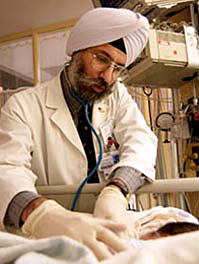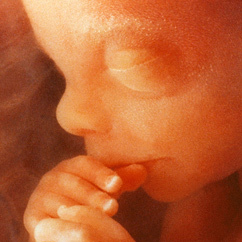Can the foetus in the womb feel pain?
“When the surgeon lowered his scalpel to the 25-week-old fetus, [anaesthesiologist] Paschall saw the tiny figure recoil in what looked to him like pain. A few months later, he watched another fetus, this one 23 weeks old, flinch at the touch of the instrument. That was enough for Paschall. In consultation with the hospital’s pediatric pain specialist, “I tremendously upped the dose of anaesthetic to make sure that wouldn’t happen again,” he says. In the more than 200 operations he has assisted in since then, not a single fetus has drawn back from the knife.“
Annie Murphy Paul, ‘The First Ache,’ New York Times Magazine, 10 February 2008, http://www.nytimes.com/2008/02/10/magazine/10Fetal-t.html
Quick Facts on Foetal Pain
According to the leading medical experts in the field of prenatal surgery, an unborn baby certainly feels pain at 20 weeks gestation.
- In 2004 Dr. Robert White, a brain surgeon and neuroscientist at Case Western Reserve University , testified in a US District Court that by the 20th week, the unborn baby not only feels pain, but has a higher pain sensitivity than adults.[1]
- Dr. KJS Anand’s groundbreaking study of foetal pain showed that sensory receptors begin developing at 7 weeks. They spread to the whole face, palms and hands by 11 weeks, the trunk and upper arms and legs by 15 weeks, and the rest of the body by 20 weeks.[2] The sensory part of the brain, the neocortex, begins developing at 8 weeks, and is fully formed by 20 weeks.[3]
- A prenatal anaesthesiologist at Vanderbilt Hospital noted that under minimal anasthaetic, the foetus moved away from the scalpel and visibly flinched when touched by the knife. In consultation with a paediatric pain specialist he raised the anaesthetic, and has since assisted at 200 operations without observing any flinching or other signs of foetal pain.[4]
- An Indian study on foetal anaesthesiology determined that the foetus feels stress, and anaesthesia for in utero surgeries is appropriate and requires expert attention.[5]
- The unborn baby's nervous system remembers pain. The same study shows that in utero stress leads exaggerated pain responses in eight-week old infants.[6]
- The Journal of the American Medical Association promotes the usage of anaesthetics for foetal surgery.[7] It's worth noting that, until only decades ago, new born and premature babies did not receive pain relief during surgery as doctors considered that their nervous systems were too immature to sense pain.
- Data in the British Medical Journal and the Lancet gave solid confirmation of such pain. It is known that the foetal umbilical cord has no pain receptors such as the rest of the foetal body. Accordingly, they tested foetal hormone stress response, comparing puncturing of the abdomen and of the cord. They observed "the foetus reacts to intrahepatic (liver) needling with vigorous body and breathing movements, but not to cord needling. The levels of these hormones did not vary with foetal age."[8]
-
Another British study commented on this: "It cannot be comfortable for the foetus to have a scalp electrode implanted on his skin, to have blood taken from the scalp or to suffer the skull compression that may occur even with spontaneous delivery. It is hardly surprising that infants delivered by difficult forceps extraction act as if they have a severe headache."[9]
-
American Medical News reports, "Physicians know that foetuses feel pain ... because [among other things]: "Nerves connecting the spinal cord to peripheral structures have developed between six to eight weeks. Adverse reactions to stimuli are observed between eight and 10 weeks"[10]
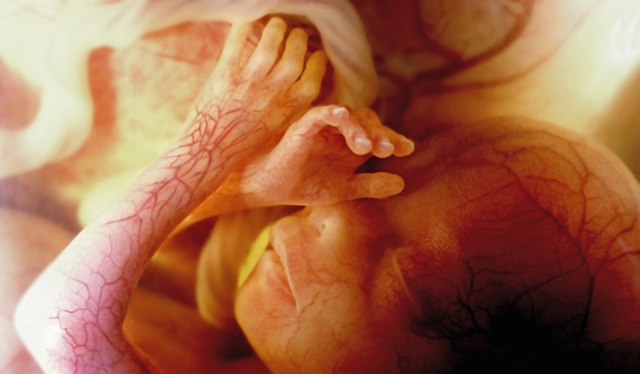
Structures are present to feel Pain
A Unique System
Scientists have shown that newborn babies have a "unique" nervous system which makes them respond differently to pain than adults.
In research that has far-reaching implications for the medical and surgical treatments of infants, the scientists have found that newborn children feel pain longer and more sensitively. In premature babies, the mechanism that allows older children and adults to "dampen down" the pain messages does not work properly.
Until recently it has been presumed that a baby's pain system was too immature to function properly, or that they reacted in a similar way to adults, but less efficiently. Researchers at University College London have now discovered that babies' sensory systems have a unique pain-signalling mechanism, which disappears, as they grow older.
In the absence of confirmatory communication because of the inability of the foetus to tell us of her pain, medical practice and science judge that pain exists when anatomical structures necessary to pain sensation are in place and when physiological responses normally associated with pain occur.
In other words, if the biological sensory machinery exists, if something causes a response like that which pain would cause, and if that something would elicit the same response from human beings generally, then we can deduct that pain occurs.
Neurological Structures
With conscious experience, or soon after, comes the possibility of feeling pain.
The development of the central nervous system leading to "functioning neurological structures necessary for pain sensations" at an age between 8 to 13.5 weeks begins early in the child. As was stated before, "commencing at eighteen days the developmental emphasis is on the nervous system"; and "by the end of the twentieth day the foundation of the child's brain, spinal cord and entire nervous system will have been established."
Certain neurological structures are necessary for pain sensation:
- Pain receptive nerve cells
- Neural pathways
- The thalamus
The thalamus is a portion of the brain that "lies above the spinal cord and brainstem, but below the cerebral cortex." The cortex is the seat of higher mental functions. It is very significant, in the present context, that the presence of a functioning cortex is not necessary to pain sensation. Even complete removal of the cortex does not eliminate the sensation of pain; no portion of the cortex, if artificially stimulated, results in pain sensation.
It follows, therefore, that neither the presence of the cortex nor transmission of pain impulses to the cortex are essential to pain sensation. When the cortex (which develops and functions later in human gestation than the thalamus) is involved in a pain response, it generates elaborated aversive behavior and adds psychological and cognitive components to pain sensation.
In the skin and throughout the body are free nerve endings that act as pain receptors. These pain receptive cells are called nociceptors. When a nociceptor is affected by a noxious stimulus - something harmful or potentially harmful to the cell - it discharges an electrical impulse that travels through interfacing nerve fibers to the spinal cord, and often to the brain.
However, a nociceptor may be stimulated and result in a reflex response without causing pain awareness. A reflex response in its simplest form, is a movement following a stimulus: it is an automatic reaction such as a child withdrawing her hand from a hot object.
By studying sensory nerve cells in infants, scientists discovered that their reflex to pain or harm is greater and more prolonged than that of adults. The sensory nerve cells are also linked to larger areas of skin which means that they feel pain over a greater area of their body. While adults produce pain reflexes only when they encounter harmful stimulation, newborn children respond less selectively and produce the same reflex even to a light touch
Scientists believe that this is because in babies, the sensory nerve fibres that communicate non-harmful touch - known as A fibres - end in a different part of the spinal cord than adults.
But in adults the cells are connected only to pain-transmitting C fibres. Maria Fitzgerald, Professor of Developmental Neurobiology at the Thomas Lews Pain Research Centre, based at UCL, said another contributing factor in the new born child's pain system is that the nerve pathways, which carry pain-inhibiting messages from the brain stem to the spinal cord, mature later than other parts of the system. [11]
Prof. Fitzgerald adds: "These nerve fibres from the brain stem start to grow down the spinal cord early in foetal life, but they do not extend branches into the spinal cord for some time, and do not function fully until soon after birth." This means the premature baby cannot benefit from the natural pain-killing system which, in adults, dampens down pain messages as they enter the nervous system.
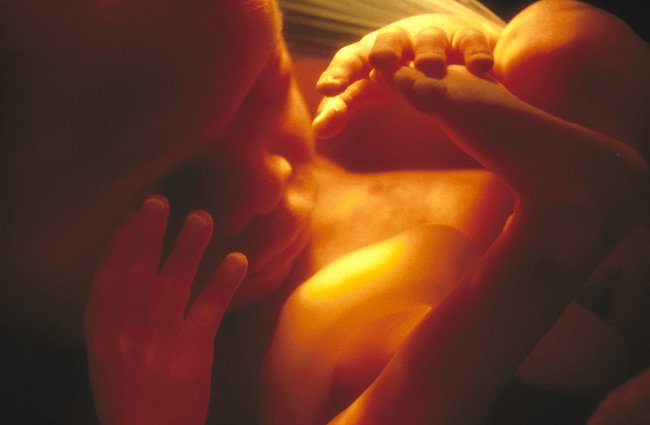
Sensitive to touch
By 10 weeks, the palms of the hands are sensitive to touch, and at 11 weeks the face and extremities likewise respond to tactile stimuli. By 13.5 weeks, these responses are sufficiently elaborate and sufficiently avoidant to warrant the definite conclusion that the foetus responds aversively, not reflexively. They evidence an integrated physiological attempt to escape noxious stimuli.
Expert Testimonies
"Cutaneous sensory receptors appear in the perioral area in the seventh week of gestation."
Anand et al., "Pain and Its Effects on the Human Fetus N. Eng. J. Med, vol. 317, no. 21, p. 1322, Nov. 19, 1987
"Pain isn't just psychological. There is also organic, or physiological pain which elicits a neurological response to pain."
P. Lubeskind, "Psychology & Physiology of Pain," Amer. Review Psychology, vol. 28, 1977, p. 42
"Changes in heart rate and foetal movement also suggest that intrauterine manipulations are painful to the foetus."
Volman & Pearson, "What the Foetus Feels," British Med. Jour., 26 Jan 1980, pp. 233-234.
"The changes in heart rate and increase in movement suggest that stimuli are painful for the foetus. Certainly it cannot be comfortable for the foetus to have a scalp electrode implanted on his skin, to have blood taken from the scalp or to suffer the skull compression that may occur even with spontaneous delivery. It is hardly surprising that infants delivered by difficult forceps extraction act as if they have a severe headace."
Volman & Pearson, "What the Foetus Feels," British Medical Journal, 26 Jan 1980
Dr Kanwaljeet Anand [is] director of the Pain Neurobiology Laboratory at the University of Tennessee Health Science Center in Memphis. Some of Anand's earliest research showed that newborns were far more likely to survive operations when given anaesthetics. That made him wonder what happens before birth. Since then, he said, studies have shown that the foetal brain and body are coordinated enough to experience pain by between about 18 and 20 weeks. When a foetus of that age gets a blood transfusion, for example, changes in heart rate and blood pressure accompany shifts in circulation and spikes in stress hormones. A morphine-like drug calms all of those responses down.
[N]ew evidence, he argued, suggests that the very young brain is developed enough in the right places to take in those sensations and translate them into pain. "It's excruciating," he said. "Not only is sensitivity to pain higher in the fetus, it doesn't know when the pain is going to end."
Emily Sohn, ‘Do Fetuses Feel Pain?’ Discovery News, 26 April 2010 http://news.discovery.com/human/fetus-pain-abortion-law.html
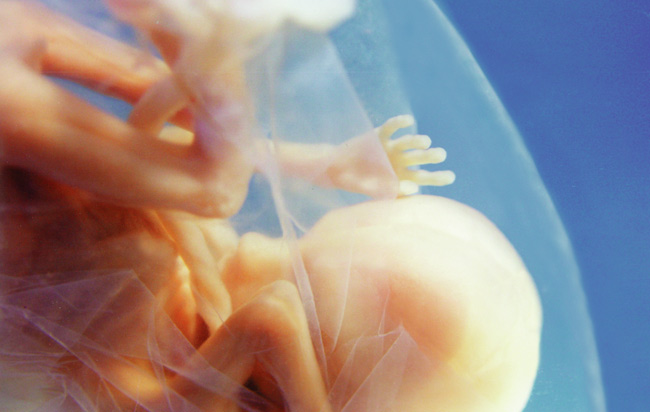
References and Sources
[1] National Abortion Federation et al. v. John Ashcroft, August 26, 2004, Findlaw.com, http://fl1.findlaw.com/news.findlaw.com/cnn/docs/abortion/nafash82604opn.pdf
[2] KJS Anand, and PR Hickey, ‘Pain and Its Effects in the Human Neonate and Fetus,’ New England Journal of Medicine Vol. 317, no. 21, 1321-1329, 19 November 1987. http://www.cirp.org/library/pain/anand/
[3] KJS Anand, and PR Hickey, ‘Pain and Its Effects in the Human Neonate and Fetus,’ New England Journal of Medicine Vol. 317, no. 21, 1321-1329, 19 November 1987. http://www.cirp.org/library/pain/anand/
[4] Annie Murphy Paul, ‘The First Ache,’ New York Times Magazine, 10 February 2008, http://www.nytimes.com/2008/02/10/magazine/10Fetal-t.html?_r=1&pagewanted=all)
[5] Kirti N Saxena, ‘Anaesthesia for Fetal Surgeries,’ Indian J. Anaesth, 2009 October; 53(5), 554-559; reposted at PubMed, http://www.ncbi.nlm.nih.gov/pmc/articles/PMC2900087/
[6] Kirti N Saxena, ‘Anaesthesia for Fetal Surgeries,’ Indian J. Anaesth, 2009 October; 53(5), 554-559; reposted at PubMed, http://www.ncbi.nlm.nih.gov/pmc/articles/PMC2900087/
[7] The Journal of the American Medical Association, ‘Fetal Pain: A Multidisciplinary Review of the Evidence,’ http://jama.ama-assn.org/content/294/8/947.short
[8] M. Fisk, et al., Fetal Plasma Cortisol and B-endorphin Response to Intrauterine Needling, Lancet, Vol. 344, July 9, 1994, Pg. 77
[9] Valman & Pearson, "What the Fetus Feels," British Med. Jour., Jan. 26, 1980
[10] MD Group Claims that Foetuses Suffer Pain," in American Medical News (pub. by The American Medical Association), Feb. 24 1984, p. 18
[11] For documentation of the information related in this section, as well as Maria Fitzgerald’s research, please reference Parliamentary Office of Science and Technology, POST note 94, February 1997.
Anand et al., ‘Pain and Its Effects in the Human Neonate and Fetus,’ New England Journal of Medicine, Volume 317, Number 21: Pages 1321-1329, 19 Nov. 1987. Read the article here
‘Human Sentience Before Birth,’ Rawlinson Report, London: HMSO, 1996. Read the Article here
Gingras, Mitchell, Grattan, Archive of Diseases in Childhood Fetal Neonatal Ed., 2005, 90:F415-F418 Read the report here
‘Fetal Pain,’ International Association for the Study of Pain, Pain Clinical Updates, Vol. XIV, no. 2, June 2006. Download the report here





